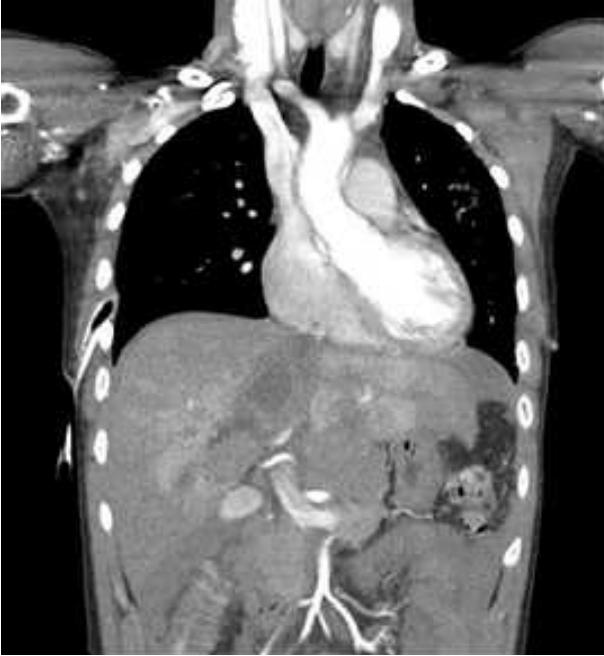Delayed Two-Stage Hybrid Management for a Thoracic Aorta Pseudoaneurysm in Polytrauma
Article information
Abstract
We successfully managed a traumatic thoracic pseudoaneurysm using a delayed two-stage hybrid approach in polytrauma.
CASE
A 19-year-old man who was on the backseat of a motorcycle involved in an accident was transferred from a regional hospital to our trauma center for management of a thoracic aortic injury. Chest computed tomography (CT) revealed a pseudoaneurysm at the proximal descending thoracic aorta with a mediastinal hematoma. The pseudoaneurysm was located near the origin of the left subclavian artery (Fig. 1.). Abdominoplevic CT revealed concomitant severe hepatic laceration (grade IV) (Fig. 2.). He was admitted to the trauma intensive care unit and managed pursuant to treating the aortic dissection. On the following day, prophylactic embolization at both hepatic arteries was performed because of aggravating abdominal distension. Therefore, we planned a delayed two-stage hybrid approach for the pseudoaneurysm. After day 9, we performed arch debranching with an 8-mm artificial graft (HemashieldⓇ) of the left common carotid artery and left subclavian artery (Fig. 3.) in the operating room. Three days after the debranching, thoracic endovascular aortic repair (TEVAR) was performed using 26–110 mm Seal stent graft (S&G Biotech, Seongnam, Korea) in the intervention room (Fig. 4.). Dysarthria was observed after the TEVAR. Brain CT angiography and consultation with a neurologist revealed occlusion of the right superior cerebellar artery due to the embolus. Anticoagulation was started and symptoms improved. The patient was discharged without complications on day 25 after admission.
DISCUSSION
Blunt aortic injury is the second leading cause of death [1]. According to management for blunt aortic injury according guidelines [2], it is feasible to delay repair for polytrauma patients with other severe concomitant injuries, especially if they are hemodynamically stable. Since 1997, endovascular repair has been widely used for management of aortic injury, and high success rates and low mortality rates compared with surgical treatment have been reported [3]. However, trauma-related injuries located at an acute angle of the aortic arch and a short distance from arch vessels may predict a higher risk of endograft failure [4]. Mosquera et al. [5] reported that 37.9% of the conservative group had an aortic-related complication in long-term results, and the survival rate was decreased at 10 years (75.6% at 1 year, 72.3% at 5 years, and 66.7% at 10 years). Survival in the surgical group remained at 77.2% at 1, 5, and 10 years and in the endovascular group was 85.7% at 1 and 5 years [5]. A hybrid approach for injuries that are unsuitable for endovascular repair alone is applicable for thoracic aortic aneurysm [6]. A delayed two-stage hybrid approach for a blunt thoracic aortic injury needing repair may be a feasible strategy for management of polytrauma patients.
Notes
CONFLICT OF INTEREST
No potential conflict of interest relevant to this article was reported.


